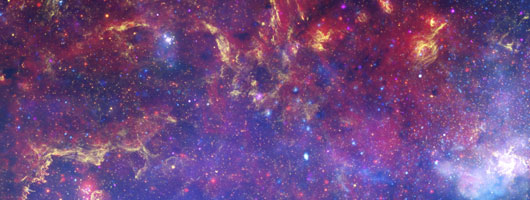GRB HEXIS
Gamma Ray Burst High Energy X-ray Imaging Survey

In response to NASA AO 98-OSS-03 we proposed a new version of the High Energy X-ray Imaging Survey (HEXIS) mission in late 1998, which would have revolutionary observational capabilities for the study of gamma-ray bursts and high energy X-ray astronomy. HEXIS was not selected for mission development (the highly successful Swift mission was selected), but HEXIS was awarded funding to develop further the HEXIS detector module.
The new HEXIS mission concept took advantage of major laboratory advances in CdZnTe detector technology by the UCSD/WUSTL/UCR/Nova R&D team that resulted in 3 keV energy resolution at 14 keV and successful imaging utilizing a coded mask and multichannel detector readout. With this new technology, HEXIS would view the entire non-occulted sky in the 5-200 kev band with an array of sensitive, wide field imaging detectors awaiting the occurrence of a gamma-ray burst brighter than 0.4 photons/square centimeter-second. During this time it will accumulate timing, spectral, and position information on >2000 hard x-ray sources with almost continuous complete sky viewing. The HEXIS mission had two primary scientific objectives: 1) Discover the origin of gamma-ray bursts, including the gamma-ray burst energy source, the evolution of the gamma-ray burst fireball, and the nature/cosmological evolution of gamma-ray burst progenitors; and 2) Perform a historic, all-sky survey in hard X-rays with 25 times the 10-100 keV sensitivity of past missions and also provide the first sky maps at 100-200 keV, from which we would investigate the origin of the Compton corona near black holes and neutron stars, deduce the effects of the magnetic field on accretion flows in pulsars, discover how jets are formed in microquasars and also in BL Lac objects, test the unified AGN model via the first systematic survey unbiased by absorption, investigate the distribution of matter near supermassive black holes in AGN, and use X-ray timing techniques to determine the masses of black holes in AGN.
This HEXIS mission is comprised of the All-Sky Continuous Imager (ASCI), two X-Ray Telescopes (XRT), and the Optical Telescope (OT). Both the XRT and OT view along the spacecraft pointing axis for simultaneous X-ray/optical data. The ASCI consists of 12 individual wide field imagers, each utilizing a coded mask above a position-sensitive CdZnTe (CZT) detector plane, with ~370 square centimeters of detector area, 1 steradian (60 degrees x 60 degrees) fully coded field of view, 26 arcminute angular resolution, and few arcminute localization capability. The imagers are arranged at both ends of the spacecraft to optimize the sky coverage which is 92% for fully coded fields. The XRT is a set of two identical, conventional grazing incidence X-ray telescopes covering the 0.5-10 keV range. Its Wolter-1, 1.6 meter focal length design --- based on the existing ABRIXAS mirror assemblies --- will have a 40 arcminute field of view and 20 arcminute half energy response. The collecting area will be 100 square centimeters at 1.5 keV with the X-ray CCD --- based on the JET-X design --- having 2 arcsecond pixels and ~100 eV energy resolution. The OT is a simple 25 centimeter aperture, 70 centimeter focal length, f6.0 Ritchey-Chretien system with a very low noise 300-900 nanometer optical CCD and a four color filter wheel. The OT is capable of detecting a 22nd magnitude object in 1 minute of observing and 1 arcsecond localization.
HEXIS would perform a continuous hard X-ray all-sky imaging survey (30 times more sensitive than BATSE on CGRO) that will provide vital hard x-ray coverage of >2000 sources and will support survey and pointed observations at lower energies (AXAF, XMM, ABRIXAS) and at higher energies (INTEGRAL). The Galactic content of the survey will include all objects brighter than 3 x 10^34 ergs/s anywhere in the galaxy. Thus, all black holes >1% of Cyg X-1, all binary X-ray pulsars >1% of Her X-1, and all microquasars >0.1% of 1915+105 are available to be studied as a class, and not as prototype objects. On the extragalactic scale, HEXIS will detect all AGN with hard x-ray luminosities above 10^42 erg/s within 100 Mpc and above 10^44 ergs/s at 1 Gpc. HEXIS will reveal hitherto undetected x-ray sources that are obscured at lower energies due to circumnuclear gas and dust. When not viewing gamma-ray burst afterglows, the telescopes will be localizing (to a few arcseconds) and studying all new sources detected by the wide field imagers, aiding in the identification of new HEXIS weak sources and measuring simultaneous x-ray and optical fluxes of selected targets.